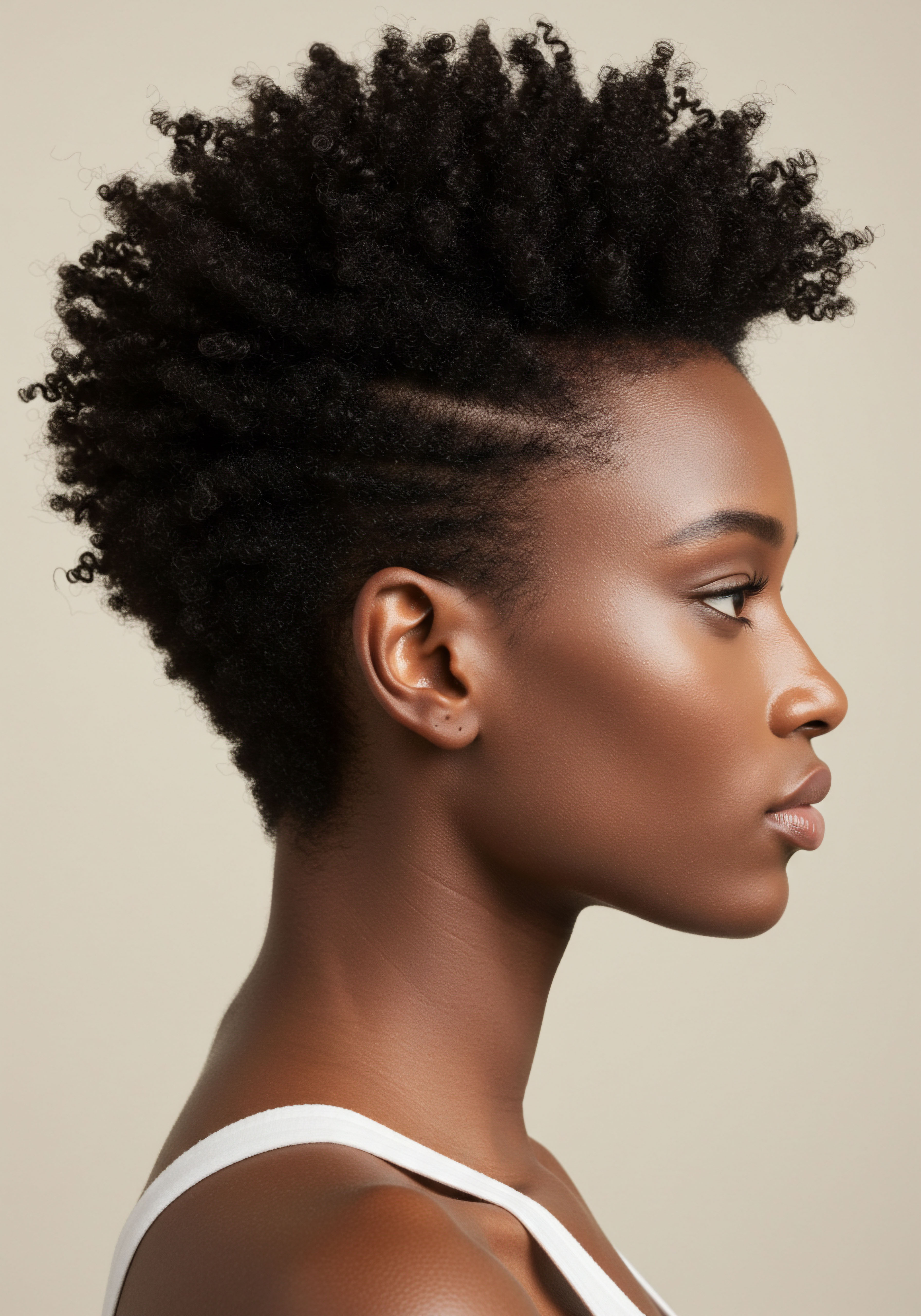
Roots
Beneath the crown of our textured hair, a silent, intricate world thrives ❉ the scalp. It is more than just a surface from which our strands emerge; it is a living terrain, a delicate ecosystem deserving of profound respect and diligent care. Often, our daily routines center on the visible, the curls and coils we shape and adorn, yet the true foundation of hair vibrancy resides in the quiet activity happening below. A deep understanding of this hidden landscape begins with acknowledging its inherent rhythms, particularly those that come alive when the world settles into slumber.

The Scalp’s Living Rhythms
The scalp, much like the rest of our body, operates on a profound, cyclical timetable. This internal clock, known as the Circadian Rhythm, orchestrates countless cellular processes, guiding everything from hormone release to cell regeneration. When we consider the scalp, this rhythm becomes especially compelling. During our waking hours, the scalp is often exposed to environmental aggressors, styling tension, and product buildup.
It is a time of defense and activity. As twilight descends, however, a shift occurs. The body, sensing the approach of rest, begins its nightly restorative work.
The scalp, like the rest of the body, possesses an intrinsic circadian clock that orchestrates its nightly renewal and repair processes.

A Nightly Renewal Cycle
During periods of genuine rest, particularly deep sleep, the scalp undergoes a remarkable period of renewal. Cellular turnover accelerates, meaning older cells are shed more efficiently, making way for new, healthy ones. This process is not merely superficial; it extends to the very follicles, the tiny structures that anchor each hair strand.
Think of it as the scalp’s dedicated night shift, where repair mechanisms are amplified, and resources are redirected to healing and replenishment. Without this nightly cycle, the accumulation of cellular debris and the slowing of regenerative processes can compromise the scalp’s health over time.

The Follicle’s Inner Clock
Research suggests that hair follicles themselves possess an independent circadian clock, a remarkable internal timekeeper that regulates their growth phases and cellular activities. This follicular clock influences the rate of cell division in the hair bulb, the part of the follicle where hair growth begins. When rest is disrupted, this delicate timing can be thrown into disarray.
For instance, studies indicate that disturbances to the circadian rhythm, such as those experienced during sleep deprivation or shift work, can directly impact hair follicle cycling, potentially shortening the active growth phase and prolonging the resting phase. This insight underscores the profound connection between systemic rest and the microscopic workings of each individual hair-producing unit.

Beyond the Strand The Scalp’s Ecosystem
The scalp is not a sterile environment; rather, it is a complex habitat teeming with microorganisms, collectively known as the Scalp Microbiome. This diverse community of bacteria, fungi, and other microscopic life forms plays a crucial role in maintaining scalp health. A balanced microbiome helps to defend against pathogens, regulate oil production, and even influence inflammatory responses. Just as rest periods influence our internal physiological balance, they also play a quiet yet significant role in maintaining the equilibrium of this microbial world.

A Microscopic Metropolis
The delicate balance of the scalp microbiome can be disrupted by various factors, including harsh products, environmental pollutants, and, crucially, prolonged periods of stress and insufficient rest. When the body is under duress from lack of sleep, it can alter the skin’s pH and sebum composition, creating an environment less hospitable to beneficial microbes and potentially allowing opportunistic ones to flourish. This imbalance can lead to common scalp concerns such as dryness, itching, or even flaking. Providing the scalp with adequate rest allows its microbial inhabitants to settle into their natural, harmonious state, contributing to a healthier barrier function.

The Protective Veil
The scalp’s outermost layer, the Skin Barrier, serves as a protective veil against external irritants and moisture loss. During restful periods, the skin barrier has an opportunity to repair and fortify itself. Cellular repair processes are more active at night, helping to mend micro-damage accumulated during the day.
This enhanced repair strengthens the barrier, making the scalp less vulnerable to dryness, irritation, and the penetration of undesirable substances. A compromised barrier, conversely, can lead to increased sensitivity and a less robust foundation for hair growth.

Why Rest Matters Cellular Repair and Detoxification
The body is a master of self-preservation and repair, but these capabilities are most potent when we allow ourselves to truly rest. The scalp, as an extension of the skin, benefits immensely from this nightly downtime. It is during these hours of stillness that the most intensive restorative work takes place, work that is absolutely fundamental to maintaining scalp vitality and, by extension, the health of our hair.

Restoring Balance Beneath the Surface
When we sleep, our body’s metabolic rate slows, allowing energy to be redirected from active functions to repair and regeneration. This includes the intricate network of blood vessels that supply the scalp with vital nutrients and oxygen. Adequate blood flow is paramount for healthy hair growth, delivering the building blocks necessary for strong strands and removing metabolic waste products. Interrupting this restorative phase through chronic sleep deprivation can compromise nutrient delivery and waste removal, creating a less-than-ideal environment for the scalp’s optimal function.

Clearing the Path
Rest periods also support the body’s natural detoxification processes. While the liver and kidneys bear the primary burden, the skin, including the scalp, plays a role in eliminating waste through sweat and sebum. A well-rested body is more efficient at these processes, ensuring that cellular waste products are cleared effectively.
This cleansing action, occurring during the quiet hours, contributes to a cleaner, clearer scalp environment, reducing the likelihood of clogged follicles and irritation. It is a subtle, yet powerful, nightly cleansing that underpins the scalp’s overall well-being.

Ritual
As we turn our attention from the silent, intricate workings beneath the surface to the practices we can consciously adopt, we find ourselves at the heart of daily wisdom. The journey to a truly vital scalp extends beyond understanding its biology; it encompasses the deliberate actions we choose, particularly as the day yields to night. Our routines, when approached with intention and gentleness, become more than mere steps; they transform into rituals, moments of dedicated care that acknowledge the scalp’s profound need for rest and replenishment. It is here, in the quiet moments before sleep, that we can actively contribute to the scalp’s nightly renewal.

Nighttime Practices for Scalp Serenity
The transition from day to night presents a unique opportunity to prepare the scalp for its restorative cycle. Just as we might wind down our minds, so too can we guide our scalp into a state of calm and readiness. These practices are not about adding complexity to an already busy life, but rather about refining existing habits with a focus on gentle support.

The Gentle Preparation
Before retiring, a simple yet impactful step involves gently cleansing the scalp of the day’s accumulation. This does not necessarily mean a full wash every night, but perhaps a light massage to stimulate circulation and loosen any debris. For those with textured hair, dry brushing with a soft-bristled brush can be a soothing way to distribute natural oils and encourage blood flow, provided it is done with extreme care to avoid tangling. The goal is to create a clean canvas, free from the weight of product buildup or environmental pollutants that could hinder the scalp’s nightly reparative functions.

Protecting the Night
Once the scalp is prepared, safeguarding it throughout the night becomes paramount. This is where protective styling and coverings truly shine. The friction from cotton pillowcases can be detrimental, leading to dryness, breakage, and irritation for both hair and scalp.
Opting for materials that reduce friction is a simple yet profoundly effective way to support scalp vitality. These deliberate choices allow the scalp to breathe, regenerate, and maintain its natural moisture balance undisturbed.

Tools and Techniques for Restful Care
The right tools, applied with a mindful touch, can significantly enhance the efficacy of nighttime scalp care. These are not merely implements but extensions of our intention to nurture and protect.

The Soft Touch of Brushing
A gentle scalp massage, whether with fingertips or a soft-bristled brush designed for textured hair, can be a calming prelude to sleep. This action stimulates blood circulation to the follicles, delivering vital nutrients and oxygen more efficiently. It also helps to dislodge any loose flakes or product residue, preparing the scalp for its nocturnal repair processes. The key is gentleness; vigorous scrubbing or pulling can do more harm than good, leading to irritation or even microscopic abrasions.
- Finger Pads ❉ Utilize the soft pads of your fingers for circular motions, applying light to medium pressure.
- Scalp Massager ❉ A handheld scalp massager with soft silicone bristles can provide consistent, even pressure without scratching.
- Boar Bristle Brush ❉ For some textured hair types, a soft boar bristle brush can distribute natural oils from root to tip, but use with extreme caution to avoid snagging.

Headwraps and Bonnets A Shield for Sleep
The use of satin or silk bonnets and headwraps is a cornerstone of nighttime care for textured hair, and their benefits extend directly to scalp vitality. These materials minimize friction between the hair and pillow, preventing moisture loss from both the hair strands and the scalp. This reduced friction also prevents the physical irritation that can occur when the scalp is constantly rubbed against rougher fabrics. A scalp that is protected from external stressors throughout the night is better positioned to conduct its cellular repair and rebalancing acts.
Protecting the scalp from friction and moisture loss during sleep, often with silk or satin coverings, significantly aids its nightly repair processes.
| Benefit Area Reduced Friction |
| Impact on Scalp Vitality Minimizes physical irritation and micro-abrasions on the scalp surface, supporting barrier integrity. |
| Benefit Area Moisture Retention |
| Impact on Scalp Vitality Helps the scalp retain its natural oils and applied products, preventing dryness and flaking. |
| Benefit Area Temperature Regulation |
| Impact on Scalp Vitality Allows for more stable scalp temperature, which can aid in healthy circulation and cellular processes. |
| Benefit Area Product Efficacy |
| Impact on Scalp Vitality Optimizes the absorption and effectiveness of any overnight scalp treatments. |
| Benefit Area These protective measures create an optimal environment for the scalp's nocturnal restorative work. |

The Art of Mindful Application
Beyond physical protection, the application of targeted products can serve as a potent part of a nighttime scalp ritual. This is where the wisdom of selecting ingredients meets the intention of mindful care.

Selecting Soothing Potions
Consider lightweight, non-comedogenic oils or serums specifically formulated for scalp health. Ingredients like jojoba oil, known for its similarity to natural sebum, or soothing botanicals like aloe vera or chamomile, can provide gentle hydration and anti-inflammatory support. The key is to choose products that nourish without clogging pores, allowing the scalp to breathe and perform its natural functions. A patch test is always recommended, particularly for those with sensitive scalps, to ensure compatibility with these nightly applications.

A Moment of Calm Connection
The act of applying these products can become a meditative practice. Instead of a hurried application, take a few extra moments to gently massage the product into the scalp, focusing on the sensation and the quiet act of self-care. This mindful connection not only helps with product distribution but also signals to the body a transition into a state of calm. The reduction of stress, even through small, intentional acts, has a direct positive influence on scalp health, as stress hormones can impact the delicate balance of the skin and hair follicles.

Relay
Having explored the foundational rhythms of the scalp and the conscious rituals that support its vitality, we now move to a more expansive view. The influence of rest periods on scalp health is not an isolated phenomenon; rather, it is intricately linked to the broader symphony of our physiological and even cultural existence. This deeper exploration invites us to consider how systemic well-being, ancestral wisdom, and the very energy of stillness converge to shape the health of our scalp and, by extension, our hair. It is a perspective that sees the scalp not merely as a biological entity, but as a sensitive receptor within a complex, interconnected system.

The Systemic Connection Body Mind and Scalp
The human body functions as a unified system, where the health of one part profoundly influences another. The scalp, often viewed in isolation, is deeply connected to our internal state, particularly our hormonal balance and stress response. These systemic factors are heavily influenced by the quality and quantity of our rest.

Hormonal Whispers in the Night
During restful periods, the body regulates the production and release of various hormones, many of which directly impact hair growth and scalp health. Melatonin, often associated with sleep regulation, has been shown to possess antioxidant properties and even influence hair follicle cycling. Cortisol, the primary stress hormone, typically decreases during sleep.
Chronic sleep deprivation, however, can lead to elevated cortisol levels, which can trigger inflammation, disrupt the hair growth cycle (potentially leading to premature shedding), and alter sebum production, contributing to scalp issues. The nightly dip in cortisol and the steady release of reparative hormones during deep sleep are crucial for maintaining a healthy follicular environment.

The Stress Response and Scalp Health
Beyond hormones, the autonomic nervous system, which controls involuntary bodily functions, shifts into a “rest and digest” state during sleep. This allows the body to prioritize repair and resource allocation. Persistent lack of rest keeps the body in a “fight or flight” mode, characterized by increased sympathetic nervous system activity.
This sustained state of alertness can constrict blood vessels, including those supplying the scalp, reducing the delivery of essential nutrients and oxygen to the hair follicles. Over time, this chronic low-level stress can compromise scalp immunity and lead to conditions like telogen effluvium, a temporary hair shedding often linked to significant physiological stress.

Cultural Wisdom and Restorative Practices
Throughout history, many cultures have understood the profound link between rest, ritual, and overall well-being, often incorporating specific nighttime practices for hair and scalp care. These traditions, passed down through generations, offer a rich source of wisdom that complements modern scientific understanding.

Echoes of Ancestral Nighttime Rituals
In various African and diasporic traditions, nighttime hair care was not merely a functional necessity but a deeply rooted ritual, often performed by elders or mothers, instilling a sense of care and continuity. These practices frequently involved gentle detangling, the application of natural oils (like shea butter or castor oil), and protective wrapping. The very act of preparing hair for rest was imbued with intention, a moment of quiet connection and protection.
These rituals minimized external stressors on the hair and scalp during sleep, allowing for undisturbed regeneration. They reflect an intuitive understanding that the scalp, like the spirit, benefits from moments of stillness and careful attention.
- Protective Wrapping ❉ Historically, various forms of headwraps or cloths were used to secure hair, minimizing tangling and breakage against sleeping surfaces.
- Oil Application ❉ Natural oils were often massaged into the scalp and hair, providing nourishment and moisture retention throughout the night.
- Communal Care ❉ In some settings, nighttime hair preparation was a shared activity, fostering bonds and passing down knowledge of care.

Modern Adaptations of Ancient Ways
Today, the resurgence of practices like bonnet wearing, satin pillowcases, and pre-sleep oiling for textured hair can be seen as a contemporary expression of this ancestral wisdom. These adaptations serve the same core purpose ❉ to create a conducive environment for the scalp’s nightly restorative processes. By reducing friction, preserving moisture, and allowing the scalp to rest without external interference, these modern rituals acknowledge the timeless principle that dedicated nighttime care is a powerful ally in maintaining scalp vitality. They bridge the gap between historical practices and contemporary scientific understanding of cellular repair and barrier function during sleep.

Beyond the Visible The Energetic Exchange of Rest
While science provides a robust framework for understanding the physiological impacts of rest, there is also a more subtle, yet equally compelling, dimension to consider ❉ the energetic exchange that occurs during stillness. This perspective, often found in holistic traditions, views the scalp as a point of connection, a sensitive area that responds not only to physical inputs but also to the quality of our inner calm.
Scalp as a Sensory Gateway
The scalp is richly innervated, a highly sensitive area that reacts to touch, temperature, and even our emotional state. During periods of deep rest, this sensory gateway has an opportunity to reset. The calming of the nervous system during sleep can reduce muscle tension in the scalp, promoting better circulation and easing any tightness that might restrict blood flow to the follicles. This physical relaxation contributes to an overall sense of well-being that reverberates through the entire system, including the scalp.
The intricate connection between systemic well-being and scalp vitality means that profound rest is not just beneficial, but a fundamental requirement for optimal scalp function.
The Deep Restorative Power of Stillness
The impact of rest extends beyond the measurable biological processes. There is a profound restorative power in stillness itself. When the body and mind are at peace, resources are conserved and directed towards healing. For the scalp, this means an optimal environment for cellular repair, reduced inflammatory responses, and a strengthened ability to withstand daily stressors.
This holistic view acknowledges that true scalp vitality arises from a harmonious interplay of physical care, systemic health, and the quiet, undisturbed rhythm of restful periods. It is in these moments of profound stillness that the scalp truly flourishes, regenerating and preparing itself for the demands of the day ahead.
Consider the findings from a study published in the Journal of Investigative Dermatology by Plonka et al. (2018), which revealed that hair follicles possess their own intrinsic circadian clock. This internal timing mechanism governs crucial processes such as cell proliferation and differentiation within the follicle.
The research indicated that disruptions to this clock, whether from irregular sleep patterns or shift work, can lead to impaired hair growth and even hair loss. This direct evidence from a scientific publication underscores the critical role of consistent, quality rest in maintaining the precise biological orchestration necessary for a healthy scalp and vigorous hair growth.

Reflection
As we conclude our exploration into the quiet yet profound influence of rest periods on scalp vitality, a singular truth emerges ❉ the well-being of our scalp is deeply intertwined with the rhythms of our existence. It is a delicate ecosystem, a sensitive extension of our overall health, patiently awaiting our moments of stillness to perform its most vital work. From the intricate dance of cellular repair orchestrated by the scalp’s own internal clock, to the gentle wisdom of ancestral nighttime rituals, and the subtle energetic exchanges of deep repose, every aspect points to the profound importance of allowing our scalp to truly rest. The journey to radiant textured hair, therefore, is not merely about external applications or styling prowess; it is an invitation to listen to the whispers of our body, to honor its need for quiet restoration, and in doing so, to cultivate a foundation of vitality that shines from within.

References
- Plonka, P. M. et al. “The Hair Follicle as a Circadian Clock ❉ A Role for Rhythmic Expression of Hair Cycle Genes.” Journal of Investigative Dermatology, vol. 138, no. 11, 2018, pp. 2467-2475.
- Oyetakin-White, P. et al. “Sleep and the skin ❉ a review of the literature.” Sleep Medicine, vol. 16, no. 1, 2015, pp. 13-18.
- Hardman, J. G. et al. Goodman & Gilman’s The Pharmacological Basis of Therapeutics. 13th ed. McGraw-Hill Education, 2017.
- Dawber, R. P. R. and H. Van Neste. Hair and Scalp Disorders ❉ Clinical and Experimental Dermatology. Blackwell Science, 1995.
- Robbins, C. R. Chemical and Physical Behavior of Human Hair. 5th ed. Springer, 2012.
- Paus, R. and G. Cotsarelis. “The Biology of Hair Follicles.” The New England Journal of Medicine, vol. 341, no. 7, 1999, pp. 491-497.
- Perrin, C. Hair Loss ❉ The Definitive Guide. Balding Press, 2020.
- Burgess, C. M. Cosmetic Dermatology. 2nd ed. CRC Press, 2005.
- Adamo, M. L. and M. L. De La Garza. “The Impact of Sleep Deprivation on Human Health.” Clinical Reviews in Allergy & Immunology, vol. 59, no. 1, 2020, pp. 101-112.